Helicopter Profiles (Bell 505)
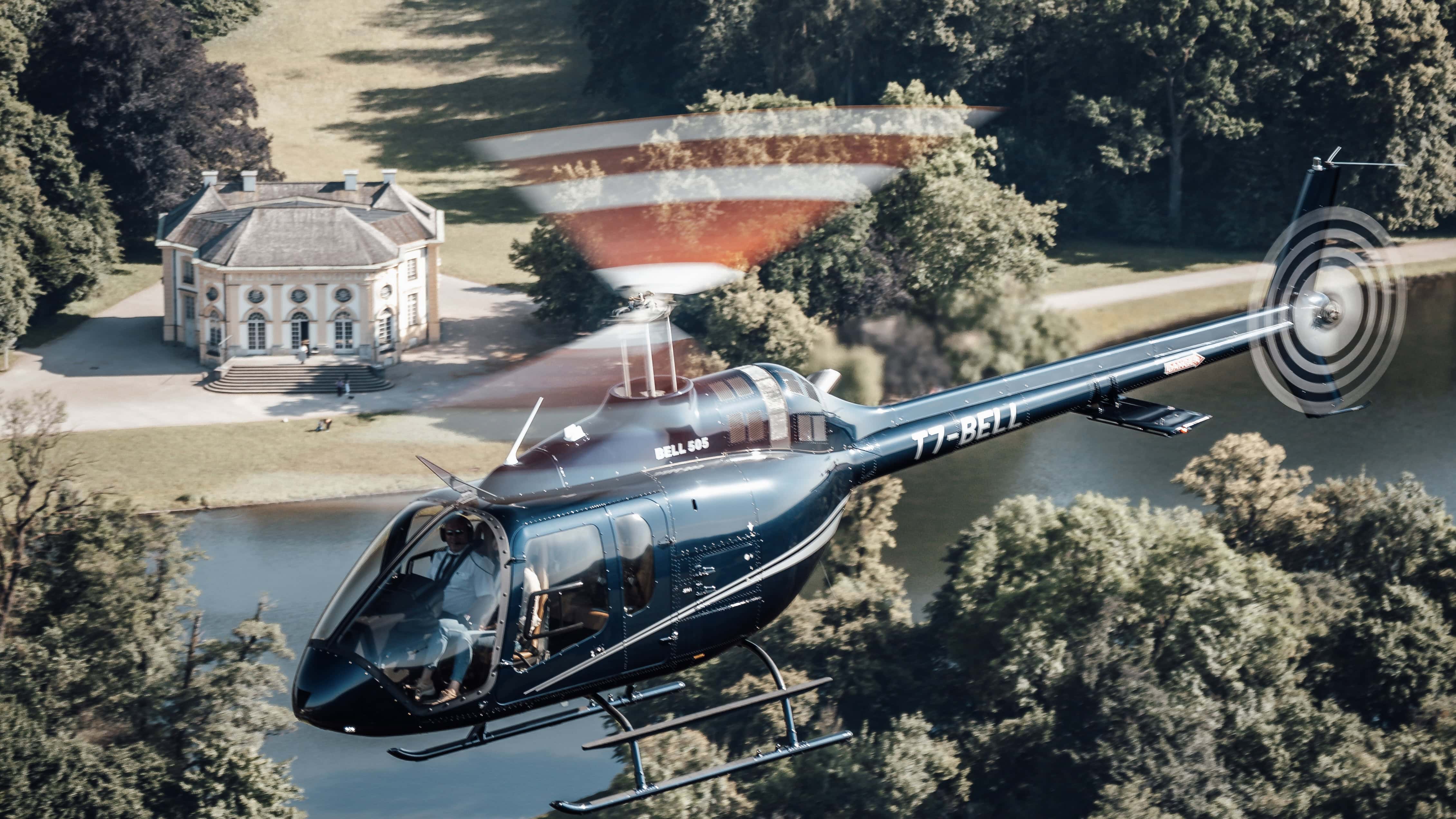
Introduction
Helipaddy has enjoyed several fabulous heli trips with a Bell 505 helicopter in the group. Our first impression was probably the smell of leather and perfume as you open the head-height doors, hinting at the solid, luxury feel of the aircraft compared to, say, the 66. It also comes at a considerably higher price, perhaps placing it in the corporate market rather than end-user.
The Bell 505 Jet Ranger X is a light single-engine helicopter introduced in 2017 as the modern successor to Bell’s famed JetRanger series. Developed with input from veteran operators, the 505 was designed to fill the gap left when production of the Bell 206 JetRanger ended in 2010. It is a five-seat rotorcraft (one pilot plus four passengers) incorporating advanced avionics, a full authority digital engine, and a proven rotor system.
As of 2025, over 500 Bell 505s have been produced (nearly 100 in 2024), serving in roles from training and private ownership to tourism and law enforcement. This overview provides an analytical look at the Bell 505’s technical characteristics – including its powerplant, avionics, rotor design, cabin configuration, safety systems, and maintenance profile – with comparisons to other light single-engine helicopters such as the Robinson R66, Airbus H120/125 series, and Enstrom 480B.
STOP PRESS: Rheinland Air Service is the official dealer for Germany and the Netherlands. RAS handles all the aircraft registration, sales and support and will launch the 505 in the Netherlands in May 2025.

Design
The Bell 505 employs a two-blade, semi-rigid (teetering) main rotor design essentially inherited from the Bell 206L-4 LongRanger. In fact, Bell deliberately used many proven dynamic components from the 206L-4 – including the rotor hub, blades, transmission, and tail rotor – to ensure reliability and predictable handling. The main rotor diameter is 37 ft (11.3 m) , giving it a larger disc than the original JetRanger and contributing to a relatively low disk loading (~16.7 kg/m² at max weight). In practical terms, the Bell 505 can enter autorotation with a generous flare and cushion, similar to the legacy JetRanger known for its forgiving autorotative characteristics. Competing designs like the Robinson R66 use a smaller diameter, lower-inertia two-blade rotor (based on the R44 rotor). Pilots report that the 505’s rotor, thanks to its inertia, feels “solid” in autorotation and in turbulence, with responsive yet predictable handling.
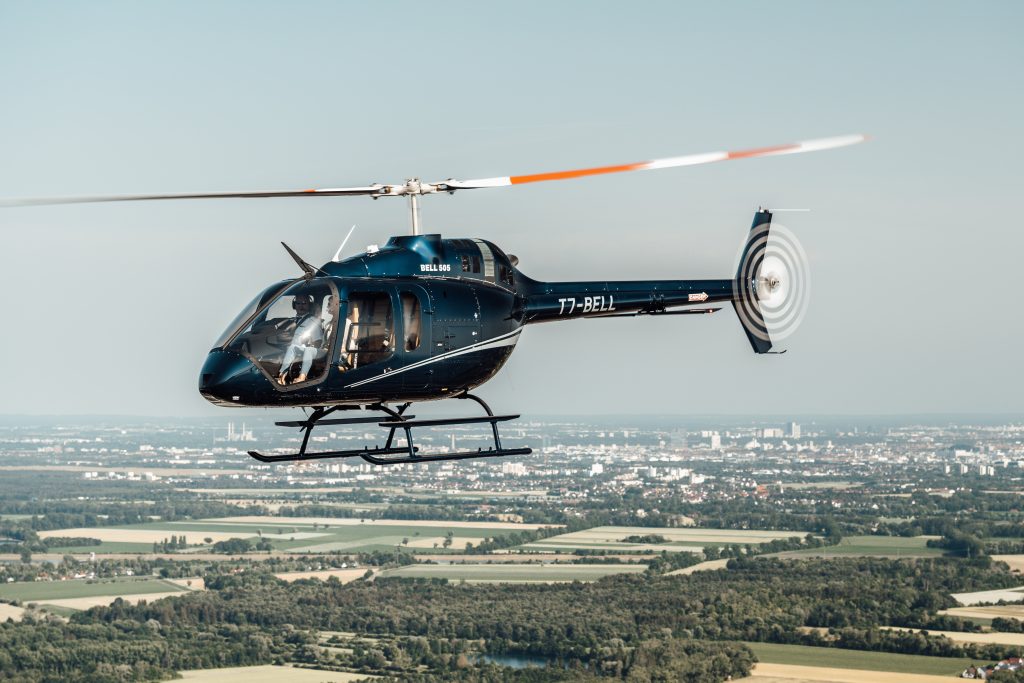
The combination of the two-blade rotor and a Frahm damper (vibration absorber) system helps reduce the 2-per-revolution vibration often associated with teetering rotor designs, contributing to a stable hover with less cyclic “hunt.” The 505’s smooth flight was very noticeable during some particularly bumpy weather over Denmark, akin to driving a Bentley across a field.
The tail rotor is a two-blade, delta-hinge design (also from the 206L4) that provides adequate anti-torque authority even at high altitudes where tail rotors can lose effectiveness. Directional control is thus robust, and the 505 does not suffer the tail rotor limitations some shorter tailboom helicopters do in hover.
Flight handling of the 505 can be characterized as a balance between the nimbleness of a small helicopter but with more solid feel of a larger platform. It is more responsive than the heavier H125 (which has a three-blade fully articulated rotor and a heavier feel). Compared to the Robinson R66, pilots might find the 505’s controls slightly heavier but more damped – likely a result of rotor inertia and possibly Bell’s control system rigging. The Enstrom 480B, on the other hand, uses a three-blade fully articulated rotor known for very high inertia and rock-steady stability, sometimes at the expense of agility.
The 505 lies somewhere in between: offering a confident hover and autorotation capability from its high-inertia rotor , with enough control crispness for maneuverability. Its hover stability is further enhanced by the optional autopilot’s Hover Assist mode, which can automatically hold a hover with minimal drift – a boon for tasks like news gathering or police operations where the pilot might be heads-down on equipment.
Performance
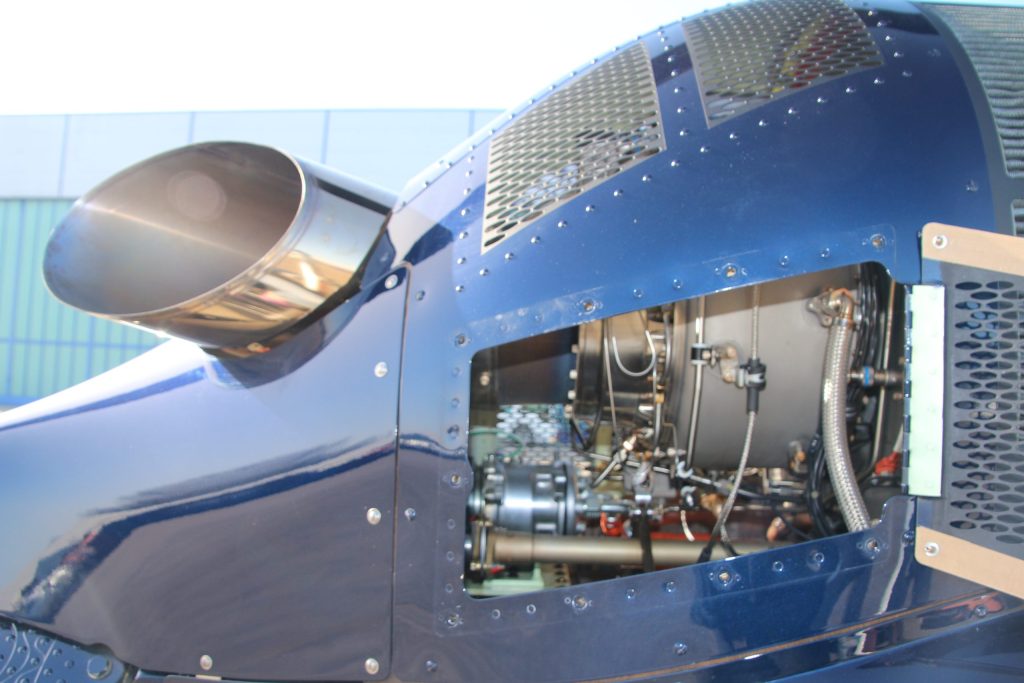
The Bell 505 is powered by a Safran (Turbomeca) Arrius 2R turboshaft engine with dual-channel FADEC (Full Authority Digital Engine Control). This engine is flat-rated to about 505 shp (377 kW) for takeoff. In practice, the 2R provides around 370–450 shp continuous, giving the 505 ample power in its weight class.
The Arrius 2R was a new engine choice for Bell but comes from a family with a reliable track record in models like the Airbus H120 (EC120) Colibri. The engine’s time-between-overhaul (TBO) is around 3,000 hours, reflecting an emphasis on low lifecycle costs and consistent with other modern turbine engines.
In terms of performance, the Bell 505 offers competitive figures for a light single. At maximum gross weight (~1,669 kg internal load), it has a maximum cruise speed around 125 knots. Flying alongside the 505 in our R66, we were pulling 83% and struggling to keep up, although enjoying the feeling if not having to refuel with our extender tank.
Typical fast cruise is in the 120–125 kt range, comparable to the slightly older Airbus H120 Colibri (around 122 kt max cruise) and faster than the Robinson R66 (about 110 kt cruise). The rate-of-climb is a strong point – the 505 can climb on the order of 1,800–1,950 ft/min under ideal conditions. This nearly doubles the climb rate of the R66 (around 1,000 ft/min at max weight) and even edges out larger single-engine helicopters like the Airbus H125 (AS350 B3e), which posts about 1,670–1,950 ft/min in climb depending on configuration. The excess power translates to confident performance in vertical lift and demanding environments.
High-altitude capability is another worthy metric. At max gross weight, the 505 can hover in ground effect (IGE) at 4,400 m.
In fact, Bell tested the 505 in mountainous regions (Himalayas, Andes) to validate its hot-and-high performance. By comparison, the R66’s service ceiling of 14,000 ft and relatively lower hover ceiling reflect its less powerful RR300 engine (approx. 270 shp continuous).
The Enstrom 480B, with a derated Rolls-Royce 250 engine (~305 shp), also has a lower service ceiling of ~13,000 ft and cruise around 110–114 kt. In short, the Bell 505’s powerplant and aerodynamics yield speed and climb performance on the high end of the light single category, providing a margin of power that is appreciated in steep climbs, confined area takeoffs, or carrying external loads (the 505 is approved for a cargo hook and up to ~1,040 kg external load).
Avionics and Autopilot
One of the Bell 505’s standout features is its modern avionics suite with Hover Assist. The Garmin autopilot was particularly jealous-making compared to the R66 Genesys.
The Garmin G1000H NXi integrated flight deck, makes it the first helicopter in its class to feature a fully glass cockpit as standard. The new R66 line up, announced at Verticon 2025 is now catching up, but we are years away from seeing that approved by the CAA.
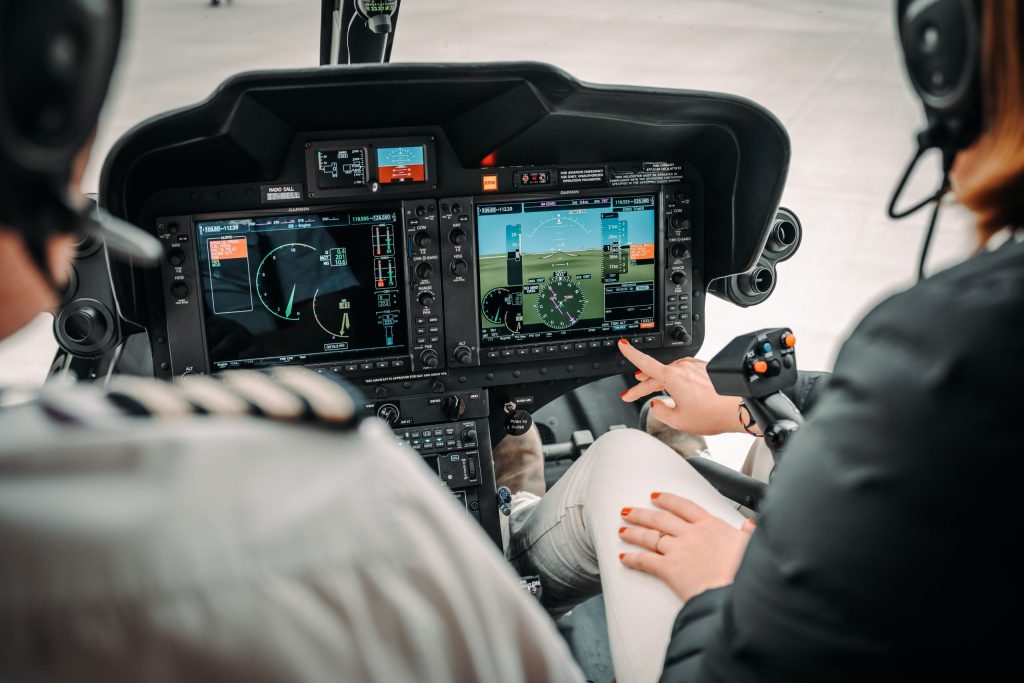
The G1000H NXi installation in the 505 includes dual 10.4-inch LCD displays (Primary Flight Display and Multi-Function Display) presenting all critical flight data, engine instrumentation, and crew alerts in a consolidated format. This provides the pilot with high situational awareness and a decluttered panel compared to traditional analog gauges. The system integrates a moving map, navigation/communication radios, GPS with WAAS, and transponder with ADS-B Out, among other functions. Engine monitoring is deeply integrated; for example, the G1000H in the 505 features a Power Situation Indicator (PSI) and engine trend monitoring, allowing the pilot to see power turbine, torque, and temps at a glance, with automated exceedance cautions.
Optional avionics upgrades include Helicopter Terrain Awareness and Warning System (HTAWS), Garmin Helicopter Synthetic Vision (HSV/HSVT), traffic advisory systems, and even video input for cameras – enhancements particularly useful for EMS, law enforcement, or low-visibility operations.
The G1000 NXi MFD is also capable of displaying DFS (Deutsche Flugsicherung) ICAO VFR charts for all of Europe with seamless transition once fully subscribed to Jeppesen.
Autopilot capability is available via the Garmin GFC 600H helicopter flight control system, which is standard (although still an option on the option list), but folks can select the cheaper Genesys system as well. Both are EASA certified. This is a 2-axis or 3-axis digital autopilot that provides stability augmentation and workload reduction tailored for rotorcraft. In the Bell 505, the GFC 600H offers functions such as Attitude Hold, Groundspeed (IAS) Hold, altitude hold, heading/nav tracking, and a GPS-integrated hover assist mode.
Critically, it also introduces advanced envelope protection features: an Automatic Level (LVL) mode that can recover the helicopter to straight-and-level at the push of a button, plus overspeed and low-G protections that guard against flight regimes that could be hazardous in a light helicopter. For example, the system will prevent the pilot from inadvertently pushing the cyclic to a low G (near weightless) condition by gently applying corrective pitch input, reducing the risk of mast bumping in the 505’s two-blade rotor system.
It also will nudge the nose up if airspeed exceeds VNE, and dampen excessive bank or pitch angles automatically (Garmin’s Helicopter ESP stability augmentation). The GFC 600H can be ordered in a 3-axis configuration that adds yaw axis (heading hold and turn coordination), which is especially useful for single-pilot operations in instrument meteorological conditions or when using the autopilot to maintain a steady hover.
These capabilities, once found only on larger twin-engine helicopters, give the Bell 505 a technological edge among light singles. By contrast, the standard Robinson R66 comes with conventional analog instrumentation (glass panels are optional aftermarket) and no factory autopilot. The Airbus H125 (AS350) and EC120 can be outfitted with modern avionics or autopilots in some variants, but an integrated Garmin suite with full digital autopilot in a stock configuration is a unique selling point of the 505. Pilots transitioning from airplanes have noted the G1000H as a major positive, as it brings familiar interfaces and reduces workload in the Bell 505.
We initially considered the R44/R66, as well as a pre-owned EC120. However, several colleagues strongly advised against the EC120 due to the extremely challenging spare parts situation. Around the same time, I had the opportunity to fly a Bell 206L—after that experience, the Robinson was immediately off the table.
I first obtained my license on the 206 and soon after completed my type rating on the Bell 505. The 505 impresses with its powerful engine performance while maintaining moderate fuel consumption. Additionally, no other light helicopter in this class offers such a modern avionics suite, including a three-axis autopilot, air conditioning, and more.
Pilot S.E.
Cabin Configuration and Mission Adaptability
Flexibility in cabin layout was a design priority for the Bell 505. The helicopter features a spacious flat-floor cabin with an open layout and wide doors for easy access.
The standard seating configuration is five seats: two in the front (pilot + co-pilot) and a three-place bench seat in the rear for passengers. All four passenger seats are forward-facing and, importantly, are energy-attenuating (crashworthy) seats meeting the latest safety standards. The rear seats are designed with quick-release attachments – they are easily removable without tools, allowing the 505 to be rapidly reconfigured for different missions.
For example, the helicopter can switch from carrying four passengers to a cargo transport role by removing the rear bench and even the co-pilot seat, yielding a completely open cabin area for freight or equipment.
The flat floor (about 22 sq ft area) has integrated tie-down points to secure cargo, and with both rear doors open (it has dual sliding or hinged doors on each side in some configurations), loading bulky items is straightforward.
Cabin comfort and visibility are notable. The cockpit and cabin windows are large and wrap-around, offering excellent outward visibility for both pilots and passengers. The rear seats are slightly elevated (stadium-style) to give back-seat passengers a better forward view under the front seats.
In terms of space, Bell quotes about 60 ft³ of usable volume in the rear cabin area, which is generous for a helicopter of this size. For comparison, the EC120 Colibri – also a five-seater – has a slightly smaller cabin volume and is often praised for comfort, but the 505’s flat floor and modular seating give it an edge in utility missions.
The Robinson R66 likewise seats five, but its rear bench is fixed and it has a more limited useful volume for cargo (the R66 does include a baggage compartment of about 300 lb capacity, whereas the 505 has both the cabin space and a dedicated baggage bay of 18 ft³ in the tail boom). The Bell’s baggage bay is external and accessible from the side, allowing storage of luggage or mission equipment without cluttering the cabin.
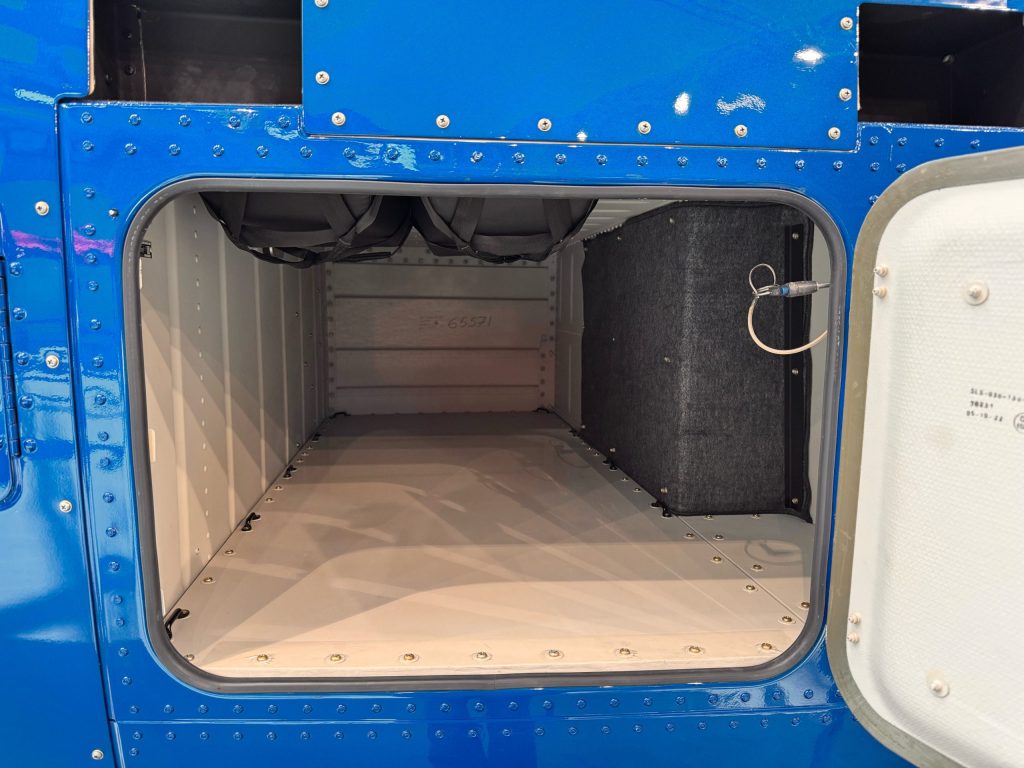
The mission adaptability of the Bell 505 is reflected in its multiple kit options. It can be outfitted with a cargo hook (for sling loads up to ~1,000 kg), making it suitable for utility lifting tasks.
It can serve as a training helicopter (some flight schools and militaries have adopted it as a turbine trainer) with dual controls and full instrumentation on both sides. For parapublic roles, provisions exist for mounting external equipment such as search lights or camera gimbals.
The avionics suite’s open architecture also allows adding mission-specific radios or sensors. In VIP/passenger transport configuration, Bell offers a premium interior trim (leather seats, carpet, headliner) to appeal to corporate and private owners.
Switching between roles is relatively quick: an operator can remove seats and install a cargo hook in a short time to go from a tour configuration to a utility lift mission. This field-reconfigurability is a selling point for operators who need one aircraft to fulfill multiple needs.
While competitors like the R66 or Enstrom 480B can also perform various missions, the 505’s larger cabin and door design (the Enstrom, for instance, is a tighter fit and only seats 3-4 adults comfortably despite technically having 5 seats) give it an advantage in terms of payload accommodation.
The Airbus H125, being a bigger helicopter, outlifts the 505 and offers more interior space, but at a significantly higher purchase and operating cost; the 505 targets a niche where versatility and cost-efficiency are paramount.
Notable Safety Features
Safety was a key focus in the Bell 505’s design, especially given lessons learned in the industry regarding crash survivability and pilot workload. The 505 comes equipped with several modern safety features that set it apart from older legacy designs:
• Outstanding Visibility: The expansive cockpit windows and thin door frames provide pilots with an excellent field of view in all directions. This is critical for see-and-avoid traffic scanning, landing site selection, and low-level maneuvers. The visibility in the 505 is often compared to that of much larger helicopters, and it surpasses the more limited view out of some competitors (for instance, the R66’s older-style cockpit has more door framing in view).
• Crashworthy Structure: The Bell 505 meets the latest crashworthiness standards (FAR 27 upgrade requirements). It features a crash-resistant fuel system to significantly reduce post-crash fire hazards , including fuel tanks designed to resist rupture. The seats for all occupants are crash energy-absorbing with four-point harnesses , designed to attenuate vertical impact forces in a hard landing. Additionally, the landing skids and underlying structure are built to deform progressively and absorb energy. (By comparison, many older light helicopters, including legacy Bell 206s and early Robinsons, did not have fully crashworthy tanks or seats; the R66 introduced some improvements but the 505 being a clean-sheet design incorporates them from the start.)
• Engine and Drive System Safety: The Safran Arrius 2R engine’s dual-channel FADEC not only optimizes performance but also provides redundancy – if one electronic control channel fails, the other maintains engine control. This prevents loss of power due to single-point failure in the engine control system. The engine also has an automatic overspeed protection. The transmission and rotor system, inherited from the Bell 206L4, have a long track record of reliability in service. Many components are life-rated and monitored, and there is a built-in chip detection system in the gearbox to warn of impending issues.
• Advanced Avionics Safety Aids: As discussed, the Garmin G1000H NXi glass cockpit reduces pilot workload by consolidating information and giving clear audio/visual alerts for any exceedances. Optional HTAWS provides terrain collision warnings, which is a significant safety enhancement for night or low-visibility flying in a helicopter (filling a gap where CFIT – controlled flight into terrain – has been a concern). The Synthetic Vision option can display a virtual terrain image on the PFD, aiding spatial orientation. The transponder’s ADS-B Out and optional ADS-B In or TAS (Traffic Advisory System) improve traffic awareness by showing other aircraft on the map.
• Autopilot Stability Protections: With the GFC 600H autopilot installed, the Bell 505 gains envelope protection like Helicopter ESP (Electronic Stability and Protection) which will gently correct the aircraft if it detects excessive bank or pitch, Automatic Level mode for instantaneous recovery to level flight, and Low-G protection to avoid mast bumping situations. These features act as an invisible safety net, especially valuable for single-pilot operations. While a 505 can certainly be flown manually, having an autopilot that actively prevents loss of control can be life-saving if a pilot becomes disoriented or distracted. Competing models in this class generally do not offer such protections; for example, neither the R66 nor the Enstrom 480 have any automatic stability system from the factory. (Some AS350/H125s can be fitted with stability augmentation or autopilots, but usually as expensive add-ons and not with the complete Garmin feature set.)
Overall, the Bell 505’s safety suite reflects the latest “Part 27” safety enhancements that regulators and manufacturers have been pushing for light helicopters, including crash-resistant fuel and seats (now required for new types). This makes the 505 an objectively safer platform to occupy compared to legacy helicopters designed decades ago. Pilots transitioning to the 505 also cite the lack of notorious quirks – for instance, it has no untenable “low rotor RPM” issues beyond the normal, and the controls are well-harmonized – contributing to safe handling qualities.
Maintenance Considerations
While detailed maintenance data is proprietary to operators, some general insights can be drawn about maintaining the Bell 505. Bell designed the 505 to leverage proven components and straightforward systems to ensure maintenance is manageable and downtime is minimized. The use of the 206L4 drive train means many parts (like rotor blades, hub, gearbox internals) are already well-understood by mechanics and have established lifespans. Additionally, the 505’s airframe uses a mix of composites and metallic structure with emphasis on accessibility. For example, the engine bay has large cowling doors that allow easy access to daily checkpoints (oil levels, filters). Line-replaceable units (LRUs) for avionics and electronics mean that many components can be swapped quickly if a fault is detected, rather than requiring lengthy repairs. The modularity of the Safran Arrius 2R engine also simplifies engine swaps or overhauls – it’s a compact powerplant that can be removed relatively quickly when needed.
Routine maintenance intervals on the 505 are comparable to its peers. Scheduled inspections occur at 50-hour (lubrication) and 100-hour intervals for smaller items, with larger inspections at 300 hours, etc., as typical for light helicopters. The 2R engine’s 3,000-hour TBO means operators can run for many years before a major engine overhaul is needed. Many 505 operators have reported that the aircraft benefits from the Textron/Bell maintenance infrastructure, which ensures parts availability and support (this was noted in owner feedback as meeting expectations for Textron reliability support).
One advantage of the Bell 505’s design is that because it’s a newer model, it meets current maintenance-related design standards that can reduce downtime. For instance, the use of HUMS (Health and Usage Monitoring System) is optional on the 505; while not standard, if installed it can track the condition of critical components (vibrations, engine parameters) and potentially allow for condition-based maintenance rather than strictly calendar-based. This trend can improve dispatch reliability over time.
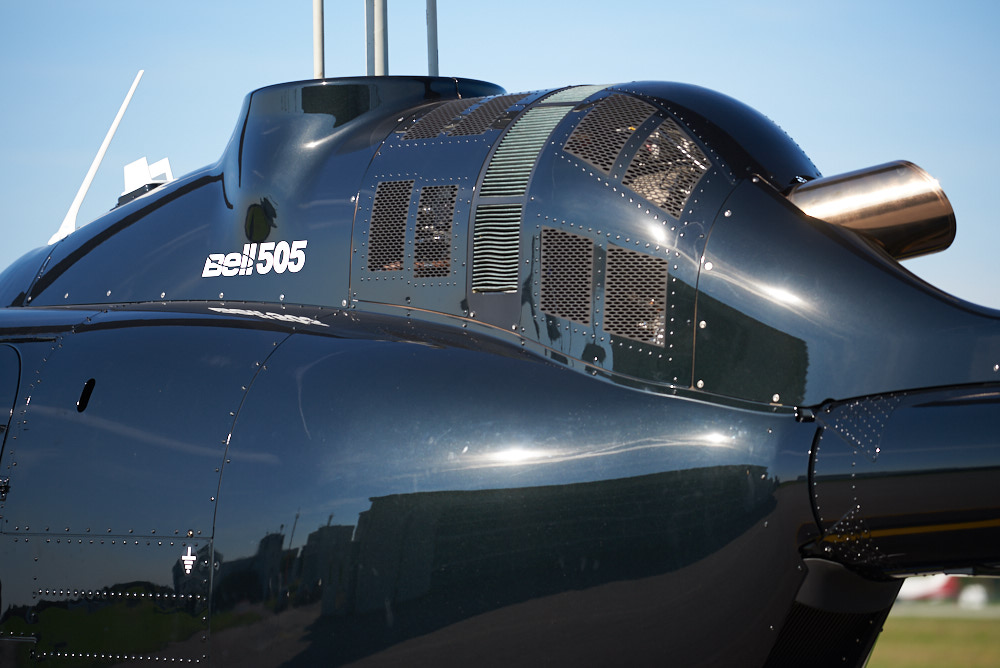
Compared to some competitors: the Robinson R66 is known for pretty low direct maintenance costs (simpler design, fewer systems), but it has short 2,000-hour overhauls mandated for many components (including the entire aircraft per Robinson’s approach). The Bell 505, with a more robust commercial-grade engine and components, has longer intervals on major overhauls (the main rotor blades for example have long life limits). The Enstrom 480B, also built ruggedly, has a good reputation for durability but Enstrom’s company support has been variable over the years, whereas Bell has a global support network.
Bell & Safran provide maintenance agreements for the airframe and engine, giving a “peace of mind” full nose to tail maintenance coverage based on a fee per flight hour, billed monthly. Programs differentiate between high time and low time usage.
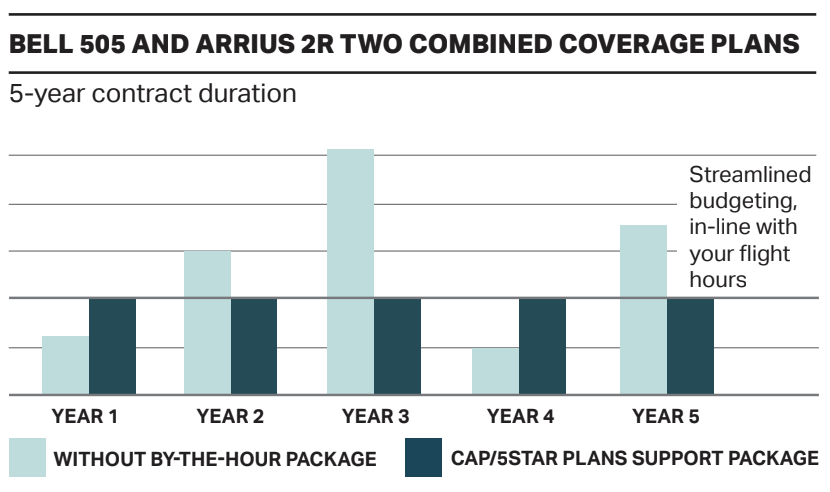
The Airbus H125, being a larger helicopter, has higher maintenance costs and complexity (e.g., its Turbomeca Arriel engine and modular gearbox), but also longer intervals on certain overhauls. In terms of downtime impact, a Bell 505 operator can expect that common parts are readily available and many mechanics are already familiar with Bell systems, which can speed up troubleshooting. Bell also offers training specifically for 505 maintenance crews (e.g., a 2-week maintenance course) to ensure technicians know the airframe. Overall, no glaring maintenance concerns have emerged in the 505’s first years of service – in one report, an owner mentioned “no maintenance challenges” and being satisfied with reliability so far.
Key competitive strengths and weaknesses
Competitive Strengths
• Modern Avionics Suite (Garmin G1000H NXi)
Fully integrated glass cockpit with synthetic vision, HTAWS, moving map, and engine monitoring—unmatched in this segment. Particularly appealing for IFR-capable or tech-savvy pilots, and those transitioning from fixed-wing.
• Strong Climb and Hover Performance
Outstanding rate of climb (~1,950 ft/min) and high-altitude hover capability (OGE >10,000 ft), making it highly suitable for mountainous or hot-and-high operations.
• Autopilot and Envelope Protection (Optional GFC 600H)
The availability of Garmin’s GFC 600H 2/3-axis autopilot with stability augmentation and low-G protection is unique among light singles. Enhances safety in high workload or degraded visual environments.
• High-Inertia Rotor System
Proven Bell 206L-4 rotor system with excellent autorotation characteristics. Offers pilots more reaction time and a stable descent profile in engine-out scenarios.
• Flexible Cabin with Flat Floor and Removable Seats
Reconfigurable interior with tool-less seat removal and integrated tie-downs supports varied mission profiles (passenger, cargo, utility, EMS).
• Brand and Support Network (Bell/Textron)
Backed by a global support structure, established parts availability, and maintenance training ecosystem—an advantage over smaller or less consistent manufacturers (e.g., Enstrom).
Competitive Weaknesses
• Higher Acquisition Cost vs R66
The Bell 505 typically costs 30–50% more than a new Robinson R66, depending on equipment. This price gap is significant for private owners or training schools focused on acquisition cost. 2026 pricing is advertised to be $1.86mn.
• No Long-Range Fuel Option
Unlike the Robinson R66, which offers an optional auxiliary tank (extending endurance to nearly 5 hours), the Bell 505 does not yet have a factory or STC-approved long-range fuel solution. With a typical endurance of 2.5 hours (no reserves), this limits its suitability for longer ferry or survey flights without intermediate stops.
The Aux Fuel Tank for the 505 was FAA-certified in 2025 and EASA certification is in progress. The clear downside is only 75 litres capacity, so it adds only about 35min endurance.
• Payload Margins Less than H125
The Bell 505’s payload capacity is adequate but well below that of the Airbus H125, which offers a higher useful load and superior external lift capability. The 505 is not ideal for heavy utility work.
• Two-Blade Rotor Limitations
The semi-rigid teetering rotor requires attention to low-G avoidance unless a GFC 600H autopilot with envelope protection is installed. Competitors with articulated rotors offer more inherent low-G tolerance.
• Not IFR Certified
Despite having advanced avionics, the Bell 505 is not certified for IFR operations. Operators seeking true instrument flight capability will need to look at aircraft like the AW119 or H125 IFR variant.
• Higher Operating Costs than R66
The more complex engine and systems in the Bell 505 result in higher direct operating costs than the simpler R66, which uses a derated RR300 with longer overhaul intervals for some components.
Other aircraft
The light turbine helicopter market features a variety of models from different manufacturers. Some notable competitors in this category include:
The light turbine helicopter market offers several alternatives to the Bell 505, each with its own design philosophy, performance envelope, and mission suitability. Notable competitors in this class include:
• Airbus H125 (AS350 B3e)
A powerful single-engine helicopter well-regarded for its hot-and-high performance, external lift capability, and ruggedness. The H125 features a three-bladed, fully articulated rotor system and is widely used in utility, aerial work, and high-altitude operations. It has a higher payload capacity than the Bell 505 but at a significantly higher acquisition and operating cost.
• MD 500 Series (e.g., MD 530F, MD 600N)
These helicopters are compact, agile, and feature a fully articulated rotor system. Some variants use the NOTAR (No Tail Rotor) system to enhance safety and reduce noise. The MD 500 series is especially popular in tactical and law enforcement roles, but cabin space and payload are more limited compared to the 505.
• Leonardo AW119Kx Koala
A heavier and more powerful single-engine turbine platform with space for up to eight occupants. The AW119Kx offers IFR capability, a higher top speed, and more cabin volume, making it a strong choice for EMS and executive transport. However, it sits in a higher weight and cost category than the Bell 505.
• Enstrom 480B
This five-seat turbine helicopter features a high-inertia, three-bladed rotor system and is known for stability and mechanical simplicity. While slower than the Bell 505, the 480B offers good autorotation characteristics and durability. Enstrom’s limited global support network may be a consideration for some operators.
• Robinson R66 Turbine
A lighter and less expensive five-seat turbine helicopter powered by the Rolls-Royce RR300. The R66 is simple to operate and maintain, with lower acquisition and running costs. However, it lacks the autopilot integration and performance envelope of the 505, particularly in climb rate and hover ceiling.
• Schweizer S333
A niche platform focused on training and utility roles. The S333 has a three-bladed rotor and basic turbine performance but is less widely adopted and lacks the avionics and payload flexibility of newer designs like the 505.
• Guimbal Cabri G2 (Piston)
Included here due to its modern rotor design and relevance for training. While piston-powered and limited to two seats, a turbine-powered variant has been explored. The Cabri G2 is notable for its flight handling and crashworthiness.
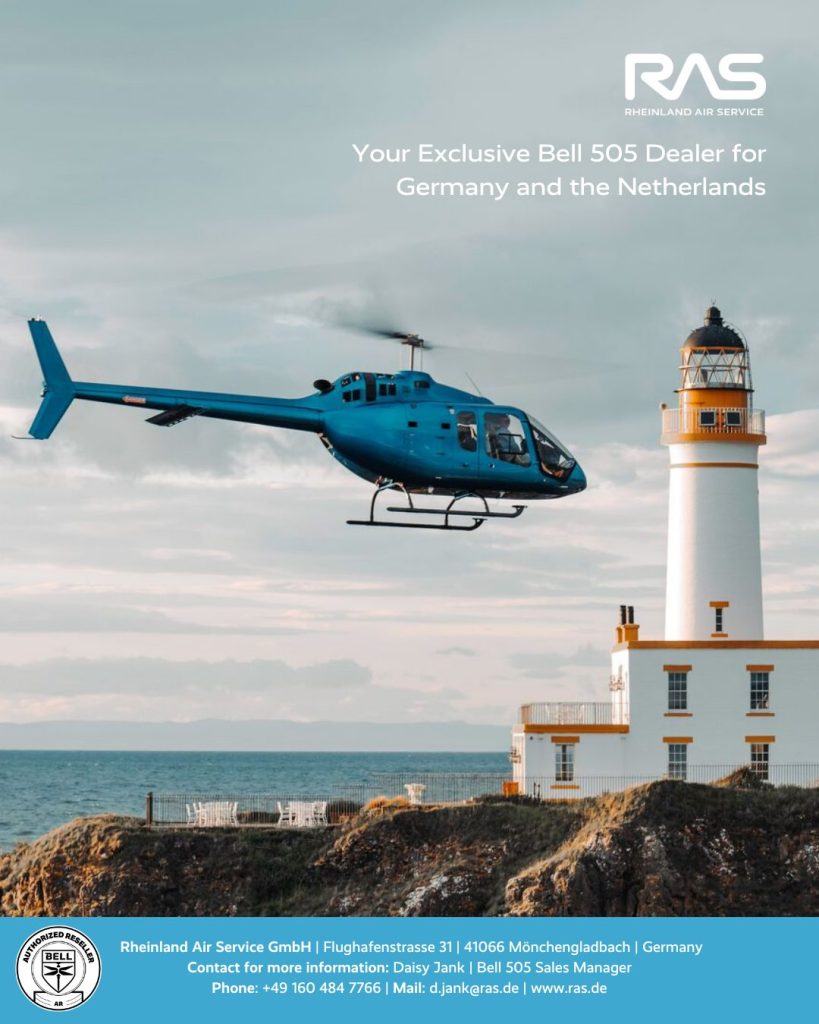



One thought on “Helicopter Profiles (Bell 505)”